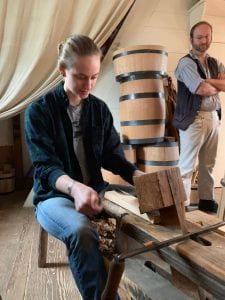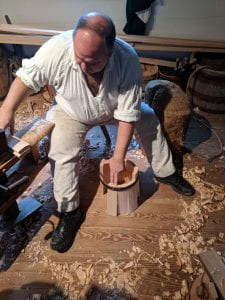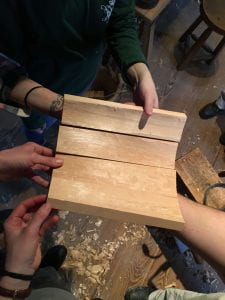No Holes in This Bucket
By Katharine Fitzgerald, WPAMC Class of 2019
We opened the gate to a large yard off Prince George Street in Colonial Williamsburg first thing Sunday morning. That’s when it hit me—the pungent smell of something fishy. As I crunched across the yard, I realized the scent came from fresh oyster shells beneath my feet, laid down the day before. This was not the entrance I expected to find for the cooper’s shop: we had spent the past two days exploring storefronts on the main roads of Colonial Williamsburg, clearly marked with trade signs or with a CW guide standing out front. The coopers of Williamsburg were an important part of the area’s economy in the eighteenth century, and I was looking forward to trying my hand at a draw knife. However, I was not expecting the sensory experience that came with that morning’s visit.

Journeyman Supervisor Cooper Jonathan Hallman demonstrating how to cut the sloping angle of a stave.
Opening a wide, white-painted barn door in the yard of the George Wythe House, I was waylaid by a new smell: Atlantic white cedar. This was what I had been expecting to find at the cooper’s shop: the warm smell of fresh-cut cedar, wood shavings underfoot, and walls of knives, saws, and cedar planks waiting to be transformed into barrels, buckets, and firkins.
We all got to try making a stave, the curved wooden boards that make up the walls of a bucket. Fortunately, the cooper journeyman, Jonathan Hallman, apprentice, Bonnie Roane, and intern, Harry Taylor III, had pre-cut staves of equal length for us. They had also shaved down the angled sides of each stave—a crucial step as these pieces would not fit together unless they were all uniformly slanting and smooth. We each picked a stave and a shaving horse—otherwise known as a cooper’s bench—and set to work.

Cutting down a stave using a hollowing knife. The cooper’s bench I used was a little low for me–so I had to tuck my feet underneath to keep my knees out of the blade’s reach. Image courtesy of J. Ritchie Garrison.
To make a bucket, each stave needs to be shaved down on both the interior and exterior surfaces to create two conforming curves. You shave the outside first, then the inside to match it. We also had iron braces to make sure the stave would have the right angle of curve. To make all this magic happen, though, we needed to use a drawknife. Bracing the stave on the shaving horse, you pull the blade of the draw knife towards you, shifting the angle as you go along, carving off little curls of cedar. As the curls dropped around my feet, I found a rhythm to using a draw knife. Although knots or other changes in the grain of the wood occasionally caught my drawknife, the right amount of pressure at the right speed made forming that curvature quick work.
The other important ingredient is light. The cooper’s shop today has electric lighting, but I sat down at a shave horse on the far side of the room, where there was only a little light coming through the window from the gray morning outside. I could see well enough, but I had to pause occasionally to pick up the stave, drawing it closer to my face and tilting it in the light to check whether I was overdoing it with the drawknife. While the sun came out later in the afternoon, I could imagine what this work would have been like on a cloudy day before electric lighting. It was certainly doable, but you would need to know exactly how the stave should feel underneath the drawknife if the light was poor. Every time I picked up the stave to examine it, I knew I would have been losing money if I were trying to make a living out of buckets.
As my classmates and I worked on our staves, we realized that we hadn’t done a terrible job at matching the curvature of the iron brace—a pretty exciting find! While the staves we made were not very pretty or uniform, we quickly realized that they could, maybe, make a bucket. With ten students in the class, we had just enough staves for this surprise project. Thanks to the quick work of our new friends in the cooper’s shop, we got a bucket to take home—which we promptly presented to our professor, Ritchie Garrison!

This year’s Craftsmanship class with professors Ritchie Garrison and Arwen Mohun, Ritchie holding the bucket made by our class and finished by the Cooper’s Shop. Image courtesy of Catharine Dann Roeber.
The morning we spent in the cooper’s shop was a wonderful surprise for me. I was expecting to learn through doing, which is what happened; I was not expecting such a sensory explanation of life in eighteenth-century Williamsburg. Through sight, smell, sound, and touch, I learned more in this cooper’s shop than I had ever expected—and crossed coopering off my bucket list!



Leave a Reply